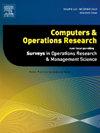期望损失函数的调整分布鲁棒界
IF 4.1
2区 工程技术
Q2 COMPUTER SCIENCE, INTERDISCIPLINARY APPLICATIONS
引用次数: 0
摘要
运营和财务中的优化问题通常包括一个成本,该成本与随机变量超过某个固定数量的预期数量成正比,称为预期损失函数。根据感兴趣的随机变量的分布,这个函数的表示通常会导致计算上的挑战。此外,在实践中,决策者可能拥有关于该概率分布的有限信息,例如均值和方差,但不知道相关概率密度或分布函数的确切形式。在这种情况下,分布式鲁棒(DR)优化方法寻求在与可用信息一致的所有可能分布中最小化最大预期成本。过去的研究已经认识到这种方法过于保守的本质,因为它考虑的是几乎肯定不会在实践中出现的最坏情况概率分布。受此启发,我们提出了一种DR方法,该方法考虑了相对于广泛类别的常见连续概率分布的最坏情况性能,同时产生的解决方案比文献中现有DR方法产生的解决方案更保守(因此,平均而言更便宜)。我们提出的方法还允许对难以或不可能精确表示的概率分布近似期望损失函数。最后,我们从文献中得出了围巾型边界与平均绝对偏差(mean -MAD)边界之间的联系,当MAD信息除了方差之外还可用时。本文章由计算机程序翻译,如有差异,请以英文原文为准。
Adjusted distributionally robust bounds on expected loss functions
Optimization problems in operations and finance often include a cost that is proportional to the expected amount by which a random variable exceeds some fixed quantity, known as the expected loss function. Representation of this function often leads to computational challenges, depending on the distribution of the random variable of interest. Moreover, in practice, a decision maker may possess limited information about this probability distribution, such as the mean and variance, but not the exact form of the associated probability density or distribution function. In such cases, a distributionally robust (DR) optimization approach seeks to minimize the maximum expected cost among all possible distributions that are consistent with the available information. Past research has recognized the overly conservative nature of this approach because it accounts for worst-case probability distributions that almost surely do not arise in practice. Motivated by this, we propose a DR approach that accounts for the worst-case performance with respect to a broad class of common continuous probability distributions, while producing solutions that are less conservative (and, therefore, less expensive, on average) than those produced by existing DR approaches in the literature. The methods we propose also permit approximation of the expected loss function for probability distributions under which exact representation of the function is difficult or impossible. Finally, we draw a connection between Scarf-type bounds from the literature, and mean-MAD (mean absolute deviation) bounds when MAD information is available in addition to variance.
求助全文
通过发布文献求助,成功后即可免费获取论文全文。
去求助
来源期刊

Computers & Operations Research
工程技术-工程:工业
CiteScore
8.60
自引率
8.70%
发文量
292
审稿时长
8.5 months
期刊介绍:
Operations research and computers meet in a large number of scientific fields, many of which are of vital current concern to our troubled society. These include, among others, ecology, transportation, safety, reliability, urban planning, economics, inventory control, investment strategy and logistics (including reverse logistics). Computers & Operations Research provides an international forum for the application of computers and operations research techniques to problems in these and related fields.
 求助内容:
求助内容: 应助结果提醒方式:
应助结果提醒方式:


